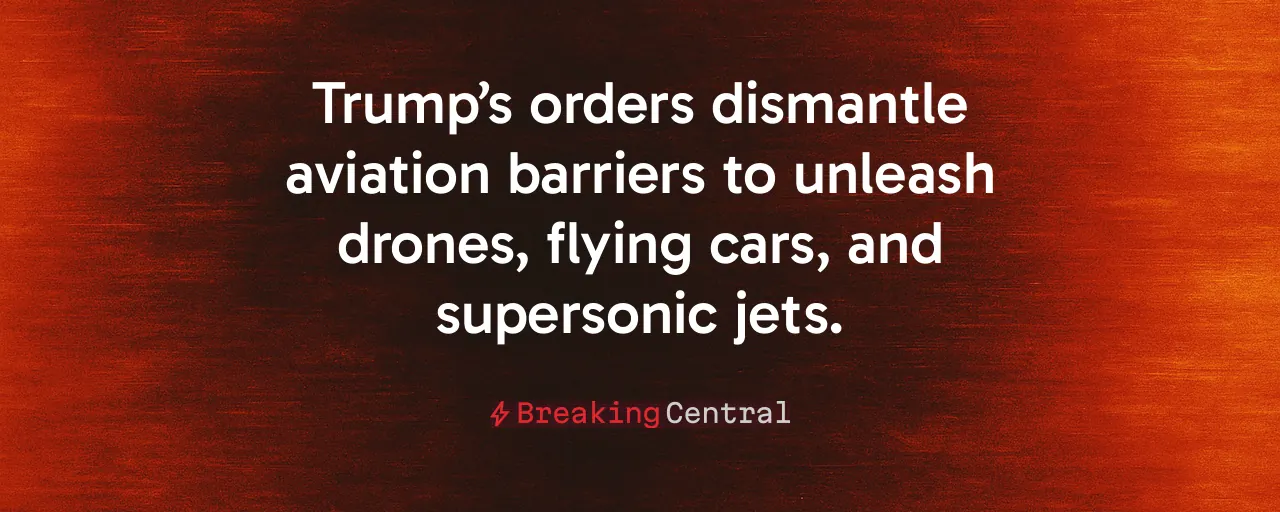Launching a New Aviation Frontier
President Trump's executive orders, signed on June 11, 2025, mark a turning point for American aviation. These directives unleash drones, flying cars, and supersonic jets, breaking decades of bureaucratic gridlock. The goal is ambitious yet clear: restore the United States as the global leader in aerospace innovation, ensuring economic growth and national security.
Excessive regulations have long stifled progress. Drones capable of delivering critical supplies or inspecting infrastructure face endless delays. Supersonic flight, a marvel of the past, remains grounded by outdated rules. Electric vertical take-off and landing aircraft, known as eVTOLs, await approval while competitors abroad advance. Trump's bold actions dismantle these barriers, prioritizing American ingenuity.
The stakes are high. Nations like China are racing to dominate aerospace technology. Trump's orders position the United States to lead, fostering a future where innovation drives prosperity and security.
Drones: Revolutionizing Opportunity
The "Unleashing American Drone Dominance" order transforms the drone industry. It mandates the FAA to propose beyond-visual-line-of-sight rules within 30 days and finalize them within 240 days. This enables long-range missions for emergency response, medical delivery, and infrastructure inspection, creating jobs and enhancing lives.
Drones could rush medicine to rural hospitals or survey disaster zones. Delays in BVLOS approvals have cost the economy billions annually, with estimates pegging losses at $10 billion. Trump's directive prioritizes U.S.-made drones, reducing reliance on foreign firms like China's DJI, banned by federal agencies over spying concerns.
Civil liberties groups and safety advocates warn that rapid deregulation risks safety or privacy. The order ensures robust tracking systems and restricted zones over sensitive sites, promoting innovation while protecting communities. This approach empowers industry while safeguarding communities.
Flying Cars and Supersonic Revival
The eVTOL pilot program is a visionary step. It selects five public-private projects within 180 days to test air taxis, medical transport, and defense logistics. These aircraft promise to ease urban traffic, speed emergency response, and bolster military capabilities. Building on Trump's 2017 drone initiatives, this program drives practical progress.
Equally transformative is the repeal of the 1973 supersonic flight ban. The order directs the FAA to set noise standards, enabling faster-than-sound travel. Flights from New York to Los Angeles could take under two hours, spurring high-skill jobs and global competitiveness.
Environmental groups raise concerns about noise and emissions. However, advanced supersonic designs are quieter and more efficient. Halting progress to placate critics risks ceding leadership to rivals. Why let Europe or China shape aviation's future?
Protecting Our Airspace
Security underpins these orders. The "Restoring American Airspace Sovereignty" directive tackles unauthorized drones, a growing threat with over 1 million registered in the U.S. It grants law enforcement real-time access to drone data and forms a Federal Task Force to counter aerial risks.
Pentagon reports highlight gaps in base defenses against drones. Trump's order deploys sensors and establishes a National Counter-UAS Training Center, preparing for events like the 2026 World Cup. By favoring domestic supply chains, it ensures self-reliance against adversarial nations.
Building on Proven Success
Deregulation has long fueled progress. The 1978 Airline Deregulation Act lowered fares and spurred competition, showing markets outperform bureaucracy. Studies link 1990s deregulation to 4.3% annual GDP growth, surpassing regulated economies. Trump's orders extend this legacy, modernizing aviation for economic gain.
Analysts who advocate for stricter oversight point to the 2022 FAA-FCC 5G dispute as a deregulation failure. The issue stemmed from poor coordination. Trump's orders unify efforts, using AI to streamline processes and enhance airspace safety. The result is a thriving, secure aviation sector.
Seizing the Future
Trump's vision charts a bold course. By slashing red tape, strengthening security, and reviving supersonic flight, these orders pave the way for an aviation renaissance. They empower entrepreneurs, protect the nation, and position the U.S. to outpace global rivals.
Hesitation hands the advantage to competitors. Do we want foreign drones inspecting our infrastructure or their jets outflying ours? Trump's orders deliver decisive action for a future where American innovation dominates the skies.
This is our moment. With decisive leadership, the United States can reclaim its airspace, drive prosperity, and lead the world. The sky is where American innovation truly begins.
